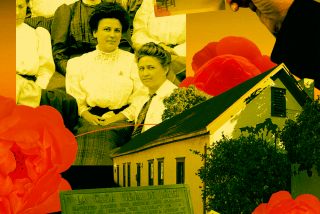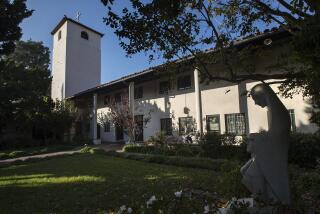He’s Headed for New Digs : Archeology: Nicholas Magalousis is moving on after 14 years of unearthing relics at San Juan Capistrano mission. He turned a sleepy tourist attraction into a well-known academic research center.
- Share via
SAN JUAN CAPISTRANO — For 14 years, archeologist Nicholas Magalousis has explored Mission San Juan Capistrano, probing the crevices of adobe buildings and the ground beneath them for clues to the history of the 217-year-old structure that has been home to Indians, Spanish soldiers, Mexican ranchers and Franciscan friars.
“I call him Indiana Jones,” said Brian McInerney, director of the mission’s visitors’ center. “Nothing makes him happier than being four feet into a hole and looking at a rock.”
This insatiable curiosity brought Magalousis to the mission in 1979, when he began converting what was once simply a beautifully landscaped tourist attraction into a highly reputable archeological research center.
But now, his curiosity is compelling him to move on.
Magalousis, 47, who has joined expeditions in Israel, Greece and Syria, has told the mission’s administrators that he is ready for new challenges. Within two months, he expects to work in other parts of the world for an international organization.
Recently, as he prepared to go on to something new, Magalousis reviewed his accomplishments at the mission: involving students from UC Irvine and Chapman University in archeological digs, greatly expanding the mission’s museum, launching a building preservation campaign and fostering docent and living-history programs.
In contrast, Magalousis, an adjunct professor of anthropology and archeology at Chapman, said that when he first visited the mission, he was surprised that no archeological digs were going on and that the mission museum consisted only of a niche in the gift shop.
“In 1979, we had quite a few universities in the area and I felt it was unusual not to have a field school on a site of this magnitude,” he said. So he persuaded Msgr. Paul M. Martin, pastor of the mission, to allow college students to begin a more scientific exploration of the mission grounds.
Over the years, Magalousis said, hundreds of students have joined the digs.
Magalousis is proud that several discoveries have illuminated the mission’s history. One of the foremost was the identification of a metal works, the oldest of its kind discovered in California.
Previously, the two large furnaces were thought to be ovens that Indian workers used to melt fat into liquid to form soap and candles. Instead, these 18th-Century, state-of-the-art Spanish furnaces were used to heat iron ore to make wrought-iron farming and religious implements.
Magalousis said that identifying the furnaces was accomplished with the help of a Mission Viejo metallurgist, Ted Koppenaal.
Magalousis said his role was to develop an environment that would encourage others, in part by identifying the archeological and historical puzzles that need to be solved.
“As I saw it, (Magalousis) was a gathering point,” Koppenaal said. “He gathered people from a wide variety of technologies and got them interested in the mission and provided them with what he could to help them along.”
Much of what Magalousis and his students have learned about the mission is contained in a treasure trove of published reports that line a bookshelf in his office. Copies of the documents, he said, are also available to researchers in the Mission San Juan Capistrano archives and at the Mission Santa Barbara, UCLA and the Sherman Foundation in Corona del Mar.
There is still plenty of exploration to be done at the mission by other archeologists, Magalousis said. “There is probably enough archeology to keep researchers busy for the next 100 years.”
If he were to return in 20 years, he said, he “would like to see the whole site excavated” and an educational center established to teach aspiring archeologists.
Gerald Miller, the mission’s administrator, said that the mission does not have funds to hire another archeologist. He said Magalousis will be available for a while as a consultant and that two archeologists working for him will stay to complete a report summarizing the research of the past 14 years.
Miller said Magalousis’ influence will not disappear. “His legacy to us will continue because of the programs he has instituted.”
More to Read
Sign up for Essential California
The most important California stories and recommendations in your inbox every morning.
You may occasionally receive promotional content from the Los Angeles Times.













